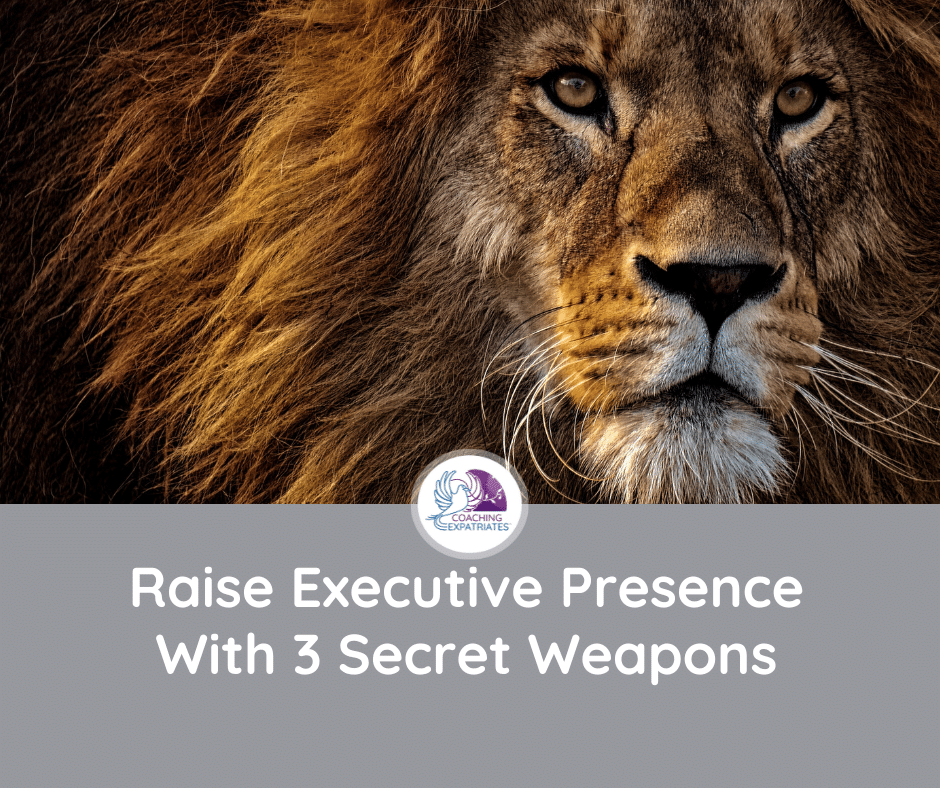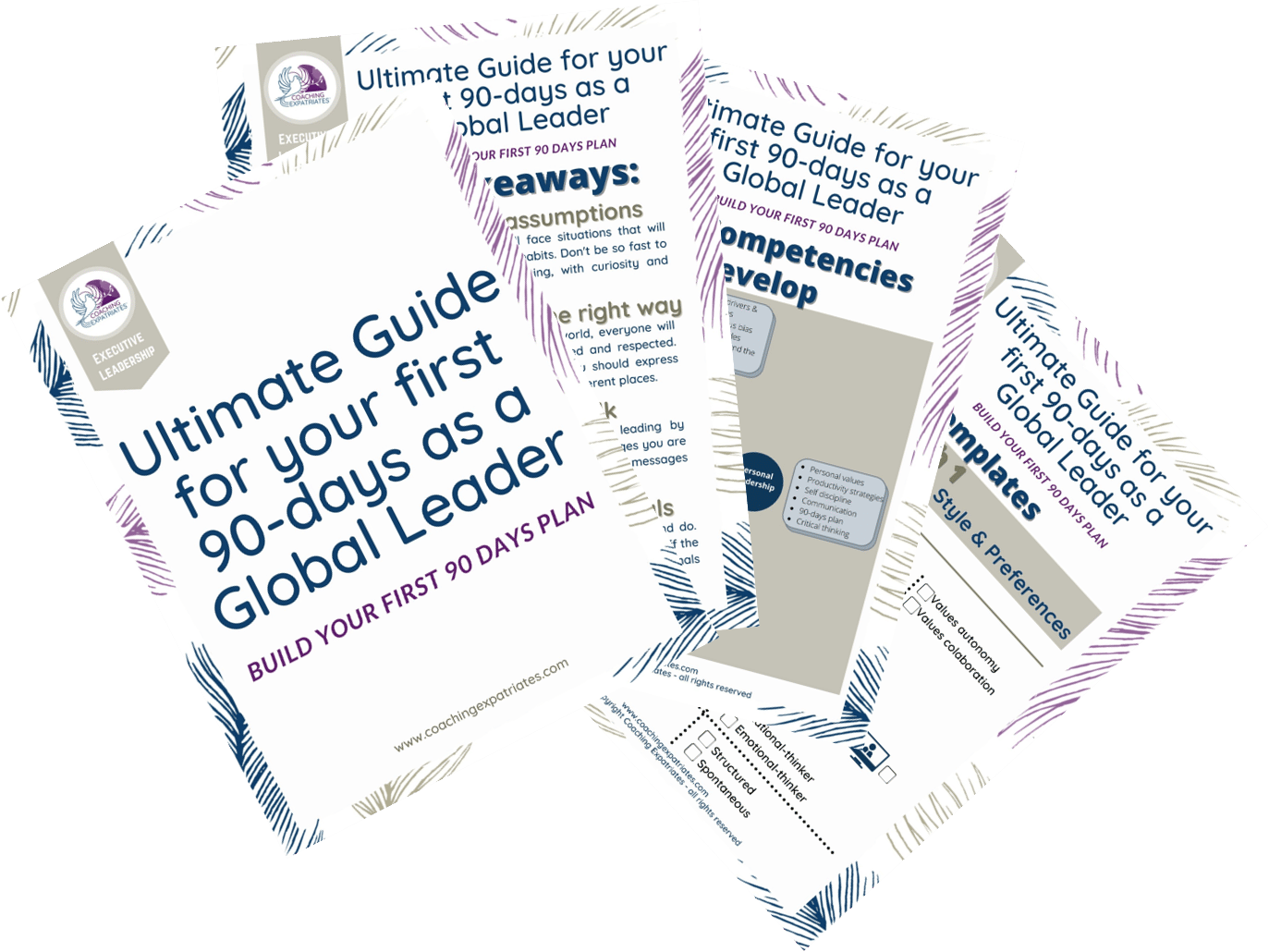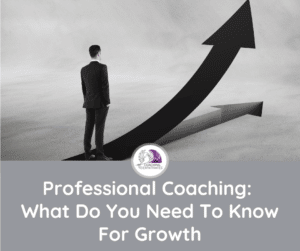Conflicts. Fierce competition. High-stakes decisions. M&As (an acronym for mergers and acquisitions). The business world is not short of needing unique and competent global executives whose strategic decisions shape the future of technologies, communities, and the world. Multicultural communication is paramount, and the concept of “executive presence” stands as a beacon of significance. It’s not just a buzzword; it’s the essence of effective leadership in our interconnected, ever-changing world.
In this blog post, we will dive deep into what executive presence truly means and why it holds paramount importance in the realm of global leadership. We will uncover the key skills that define high executive presence and unveil three secret weapons that can accelerate your journey to mastering this critical aspect of executive leadership, including the pivotal role of cultural competence.
What Is Executive Presence
During my career, especially in the very beginning, my mentors always told me to work on and pay attention to my Executive Presence, and how I was perceived by my stakeholders. It felt like they were parrots, saying over and over the same thing. The mere mention of the buzzword “executive presence” made me tick with annoyance.
I always had a hard time figuring out what they really meant by Executive Presence, because, quite frankly, none of them could give me a strong and straightforward definition of it. “Fine, executive presence. But what do I need to work on to improve it? What exactly do I need to do? And what the frak was an executive presence anyway? How to spot it?”
Explaining Executive Presence is indeed difficult because it refers to the combination of qualities and behaviors that make a leader stand out, command respect, and inspire. Because it’s a combination, there are infinite ways to combine skills and how you can actually show up with Executive Presence.
But if I had to say something from the top of my head, I would say it involves projecting confidence, credibility, and authenticity while effectively communicating, engaging, and influencing others.
In my executive leadership classes, I, in fact, go with an in-depth explanation of how Executive Presence can actually require skills in all 4 pillars of The Global Leadership Pillars™. So if you want to go a step further after reading this article, I’m throwing out there that this resource exists.
Leaders with Executive Presence have a strong presence and make a positive impact through their communication skills, ability to build relationships, and capability to inclusively inspire and motivate those around them. In short: you clearly know that a person has Executive Presence by simply being in their presence.

But you know what’s the most intriguing about Executive Presence? Anyone can learn it. And I said, anyone.
So cut through the BS whenever you hear anyone telling you that executive presence has the “It factor”: either you have it or lack it. Because if you lack it, my friend, you can learn it. So long as you want to do some legwork and practice some skills with diligence.
Why Is Executive Presence Important In Business?
Having an executive presence is important in business for several reasons. But before I outline the reasons, I will tell you a story that showcases these reasons. This way, besides providing you with some fun, the reasons will become more clear and evident.
John's TechPrime (A Fictitious Story)
Meet John Montgomery, a seasoned project management global executive with a decade-long tenure at a multinational corporation, TechPrime Inc. All names in this transformer world, I mean, transformative world, are mere coincidence. So, anyway, his reputation is built on his exceptional relationship-building skills and successful project management track record in building robots.
TechPrime Inc. is on the verge of launching a groundbreaking project that requires significant investment. John is tasked with presenting the business case to an eclectic group of stakeholders scattered around the world. His ability to influence and persuade multicultural folks is put to the test.
Some stakeholders are based in countries with different cultural norms and business practices, making effective communication a formidable challenge. John realizes that he must harness the power of cross-cultural communication to bridge these gaps.
Just as John is gaining momentum in building support for the project, a sudden financial crisis hits TechPrime Inc. The investor’s funding timing went awry, and the company will not have the full budget to work with. Which means that priorities will have to be selected and cuts made.
Because of this, John’s project budget is slashed, jeopardizing its feasibility. John’s financial literacy and problem-solving skills are called into action as he seeks a way forward. Recognizing the urgency of the situation and the need for immediate funds for cash flow elsewhere, John proposes that TechPrime Inc. explore strategic partnerships and joint ventures with other companies in the industry.
After engaging a multifunctional team, including business development folks, they finally find a suitable partner willing to love and make the same effort for this project.
All seemed good when John got out of the stage to let the partner and engineering teams work together.
Until he was called to a critical meeting, when he was chosen to represent TechPrime Inc. in a conflict with this key partner, TechBumblebee, who threatened to withdraw their funds support due to engineering disagreements. Something about not being yellow enough…
Anyway, the pressure intensifies as he must negotiate to salvage the project’s future. But in less than a week, he coordinates several meetings with the groups of engineers from both companies to reach a common ground.
With product design and funds secured, John now faces the pivotal moment when he must address his team and the stakeholders after this tense negotiation period. His executive presence comes into play as he delivers an impassioned speech that shares the next steps, expectations, and goals in a way that motivates and inspires the entire team to rise above all challenges during this stretch run.
TechPrime Inc. emerged from the crisis stronger than ever. The project was approved, thanks to John’s influence and persuasive abilities, and the new partnership that arose from a difficulty actually became strategic for the company’s growth. John multicultural communication skills not only resolved misunderstandings but also fostered stronger relationships with global stakeholders inside and outside the company.
John’s journey is one of personal and professional growth. His executive presence not only saved the project but elevated him to a new level of executive leadership within the company.
After reading this story, try to identify 3 to 5 important executive presence elements for John’s success, from start to finish, then read on.
Why Is Executive Presence So Important?
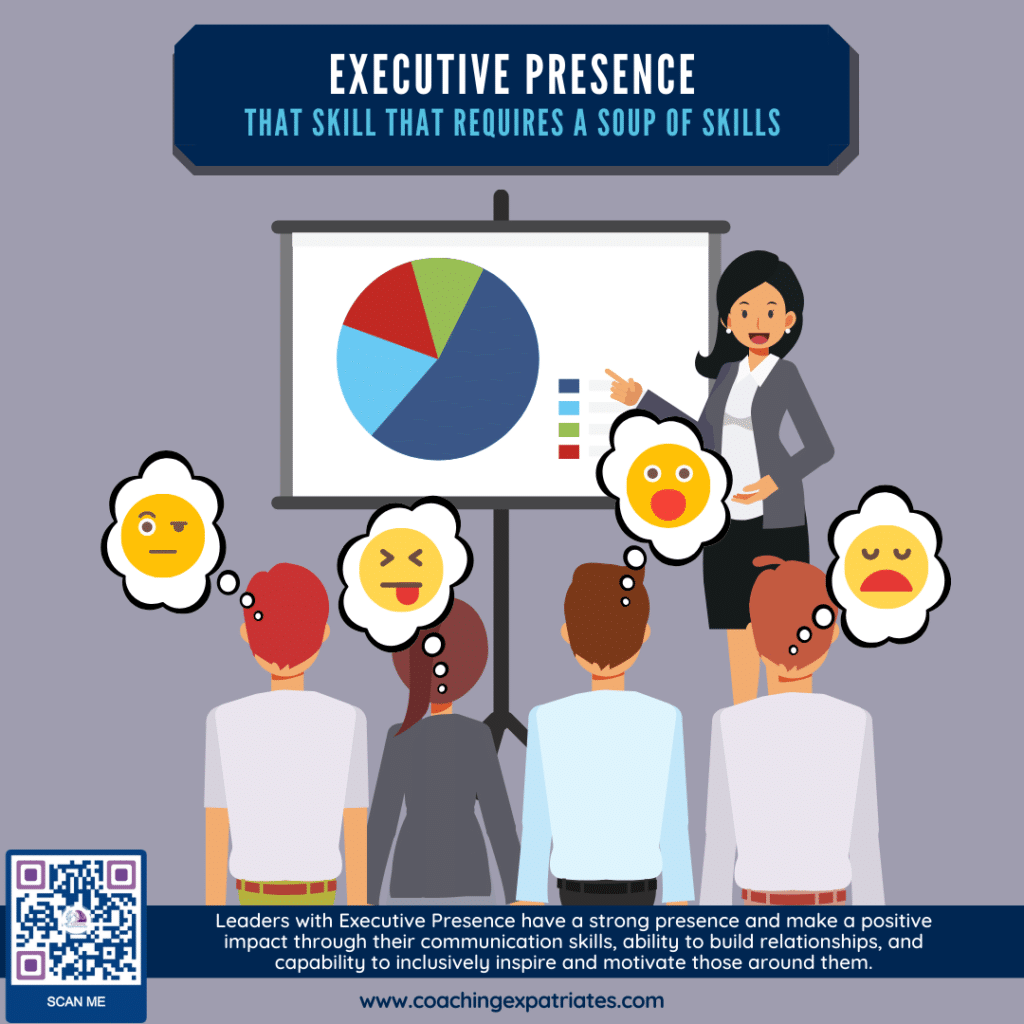
When a mentor tells you to develop executive presence, they are doing so because they know it will be required on many business occasions. Although I will outline them here in separate bullets, as you can see in John’s story, they sort of happen all together in a flow. But for didactical purposes, let’s separate them:
- Influence and Persuasion: Executive presence helps leaders inspire confidence and credibility, allowing them to effectively influence and persuade others. When leaders exude a strong presence, they can articulate their vision, motivate employees, and convince stakeholders of their ideas and strategies.
- Effective Communication: Executive Presence involves the ability to communicate effectively, both verbally and non-verbally. Leaders with strong executive presence can convey their messages clearly, listen attentively, and adapt their communication styles to different audiences. This fosters understanding, collaboration, and alignment within the organization.
- Building Trust and Relationships: Why was John selected to troubleshoot the conflict, and not somebody else? Because he already had the trust from all the parties involved. According to a Forbes article, a study by Sylvia Ann Hewlett, author of “Executive Presence,” found that executive presence is the most significant factor in determining whether a person is seen as “leadership material.” Executive Presence contributes to building trust and positive relationships. When leaders demonstrate authenticity, confidence, and emotional intelligence, they are more likely to engender trust and establish rapport with employees, colleagues, partners, or clients. Trust is essential for collaboration, loyalty, and employee engagement.
- Decision-making and Problem-solving: Leaders with Executive Presence are often perceived as decisive and capable of handling complex situations with poise. Their presence instills confidence in their decision-making abilities, allowing for more efficient problem-solving and navigating challenges effectively.
- Having Financial Literacy: Leaders who possess financial literacy are often perceived to have higher Executive Presence scores. This is because financial literacy enables leaders to provide problem-solving ideas that generate optimal financial results. By demonstrating a deep understanding of financial matters, leaders enhance their credibility and are seen as having confidence and conviction in their ideas because they are seen as people who can see beyond the immediate needs and are seeking long-lasting solutions.
- Representing the Organization: Executive Presence is crucial when leaders represent their organization externally, whether it’s in client meetings, public speaking engagements, partnerships, or media interactions. Leaders with a strong presence can positively influence the organization’s reputation, attract (or distract, i.e., entertain) investors, and foster valuable partnerships.
- Inspiring and Motivating Others: A survey conducted by the Center for Creative Leadership (CCL) found that executive presence is one of the top five factors that contribute to leadership effectiveness. Executive Presence can inspire and motivate employees to perform at their best. When leaders exhibit confidence, passion, and authenticity, they can inspire their teams, create a positive work culture, and encourage employee engagement and productivity.
Overall, Executive Presence plays a vital role in a leader’s effectiveness and influence. It helps leaders establish credibility, build trust, communicate effectively, and inspire others to achieve their goals.
You can use an attitudinal assessment to assess your Executive Presence and how you show up at work. Then, you can come up with a plan to shift areas that you need improvement. We wrote a blog post about this, where you can learn more about a unique attitudinal assessment called Energy Leadership Index Assessment.
The Skills That Support Executive Presence
In the quest to master a captivating and inspiring presence, a multifaceted executive presence skill set is essential. This freaking list is precisely what was missing for me back then when my mentors would nag about executive presence. So I wanted to create one so that people seeking detailed information on what to work on for executive presence could sigh in relief in knowing they finally had something practical and complete.
These skills collectively define the pillars of executive presence, forming a robust foundation for effective executive leadership success. Let’s delve into these skills that are crucial to crafting a compelling leadership presence:
The 3 Cs of Gravitas: Confident, Commanding, Charismatic
Confidence, command, and charisma are the cornerstones of executive presence. Confidence exudes self-assuredness, a commanding presence captivates attention, and charisma fosters genuine connection. Together, they form the bedrock of an influential leader with an executive presence.
Appearance: Neat, Clean, Professional
Your appearance is your first communication to the world. A neat, clean, and professional appearance not only conveys respect for yourself but also earns the respect of others. It sets the stage for executive presence. It’s also your first line of personal branding. Professional appearance also means situational awareness. I always loved Erin Meyer’s story about an executive warning a woman coming to Japan to avoid red clothes and flashy jewelry. Instead of understanding that the executive was giving tips on how professional appearance for women is seen there, the woman got offended by his “controlling attitude.” Different cultures and places need different professional appearances. As leaders, we have to balance local & situational needs with our authenticity, as this is part of having an executive presence.
Non-Verbal Language
Often, what is left unsaid speaks the loudest. Mastering non-verbal cues, such as body language, paralanguage, and facial expressions, is essential, especially in multicultural communication. It amplifies your message and reinforces your presence. For example, many successful leaders are said to know when and how long to keep eye contact with their audience so that they transmit a sense of credibility and interest in the other person. Using non-verbal language requires a great deal of emotional intelligence and situational knowledge, but it boosts executive presence with practice.
Cue Management: Warmth & Credibility
Balancing warmth and credibility is a delicate art of every charismatic leader. Too much warmth may diminish your credibility, and too much credibility may come off as aloofness or arrogance. Skilled cue management strikes the perfect harmony. In key leadership positions, senior leaders and executives are required to have the perfect balance between being credible, trustworthy, accessible, and inclusive. If you are intrigued by this notion, I recommend you read the book by Vanessa Van Edwards that we suggest in our Book Recommendations section below.
Multicultural Communication Models
Learning diverse communication models for understanding and interacting with multicultural leaders is vital. It empowers you to bridge cultural gaps, fostering collaboration and mutual respect among team members and stakeholders. When people think about communication skills, the first thing that comes up might be public speaking skills or presentation skills. But business nowadays requires an expanded view of communication that incorporates multicultural communication models. Some of these models are High & Low Context Communication, The Culture Map, and The Lewis Model. We wrote extensive guides on each of these models; check them out.
Self-Talk Management & Emotional Regulation
Your inner dialogue and emotional control — also called emotional regulation — profoundly impact your executive presence. Learning to manage self-talk and emotions is the bedrock of resilience, greater confidence, and poise under pressure. I once met a client who checked all skills on this list except this one. His executive presence was perceived as a disaster. How we treat ourselves and how we manage our emotions are crucial for higher executive presence. If you don’t really know where to start your executive presence improvement journey, start here. It will yield the greatest result in the long run.
Influencing Skills
Leadership hinges on the ability to influence others positively. Developing effective influencing skills allows you to drive change and achieve desired outcomes with finesse. Influencing skills, like executive presence, are a collection of many other skills and influencing tactics. To learn, practice, and improve, the best approach is to have a development partner, like a professional coach or a mentor with manager coaching skills experienced in influencing tactics, who could practice some scenarios beforehand and bounce back ideas to implement.
Empathy
Empathy cultivates genuine connections. Understanding and resonating with the emotions and perspectives of others fosters trust and camaraderie, critical elements of executive presence. Empathy, like self-talk, is one sub-skill within the emotional regulation theme, and that’s why improving overall emotional intelligence is such a critical thing for every trustworthy global executive.
Listening Skills
Active listening is a superpower in most leadership roles. It not only demonstrates respect for others’ viewpoints but also provides valuable insights for informed decision-making. You see, we often listen to respond, and every powerful leader must learn to listen to understand, first and foremost. Listening is like any other form of data collection. When we listen, we are collecting information, no matter the quality of the information. And once we see it that way, we start to pay more attention to what we are listening to before making judgments or decisions. What to make with the information or data collected through listening is a second step. Sounds easy, but real active listening requires some practice.
Reputation Management & Personal Branding
Your reputation and personal brand are assets that can enhance or erode your executive presence. Nurturing a positive image builds credibility and trust, although it happens over time and with a great deal of effort and consistency. In our Podcast, The Leadership Nest, we talk a lot about reputation management because this is a key aspect of long-lasting positive executive presence perception.
Expectation Management
Managing expectations effectively prevents misunderstandings and conflicts. Very often, when a client comes to me with a “communication problem,” we often discover together that the problem, in fact, is that expectations weren’t managed properly. Expectations management is a communication technique that aligns your goals and actions with stakeholders’ expectations, reinforcing your reliability and dependability, which are critical elements of trust-building initiatives that support executive presence. The catch-22 is that expectations management is also the alignment of your expectations about what others around you will do or say. This means that good expectations management happens in both ways: you collect expectations from others and provide yours in return. For every interaction. Allowing assumptions to close any expectation gaps is very dangerous, and the more you grow in a company’s role, the more you need to avoid making assumptions.
Business Acumen
A deep understanding of business operations, industry trends, and market dynamics is indispensable for a high executive presence. Business acumen enables you to make informed strategic decisions and influence your stakeholders to make better decisions and choices. Think about this: imagine a garden with many flowers. Among those flowers, however, you have a bunch of weeds. Business acumen is knowing your garden so well, that you know which flowers are the healthy ones and which ones are the weeds destroying other flowers. How much water do they need, and which type of soil. If you were to make any decision about your garden – say, start it over – you know it so well that any decision is a matter of strategizing, not trial and error, or guessing. Many executive leaders create a 90-day plan for collecting data and information as soon as they start a new role to tackle and quickly develop business acumen with this idea in mind.
Financial Literacy
Financial literacy is crucial for grasping the financial health of your organization. If you think that understanding finance essentials is required only by finance folks, think again. Gaining financial literacy empowers you to participate in critical financial discussions and make sound, long-lasting decisions that will support a profitable workplace. Not only that, it creates confidence among peers in your actions, words, and decisions. Because they will know your considerations or decisions are always pondered considering the financial aspect as well. I was once in a group discussion where a commercial person brought an idea that seemed absolutely brilliant but had zero financial considerations. So, as soon as the discussion developed, they realized that his solution was impractical. The guy got very frustrated, so to try to make up for it, he brought up a second idea a week later, But once again, without financial considerations. Not long after, people stopped listening to what he had to say because although his ideas seemed brilliant on the surface, none of them were well-rounded enough to include the financial aspects. He was even nicknamed “Einstein in Lala Land.” So, I hope this story demonstrates that, like business acumen, financial literacy can help or destroy your reputation quickly. Both business acumen and financial literacy are very connected with a reliability perception that people will have about you. Consider gaining financial literacy sooner rather than later in your career.
Storytelling For Professional Success
Storytelling is a powerful tool for conveying complex ideas and inspiring action. It allows you to communicate your vision, making it tangible and relatable to your audience. On top of that, research shows that leaders who use storytelling during their conversations, presentations, business cases, and even during argumentations have greater success in achieving their goals and reaching commitment when influencing people.
Here is an example: I once was in the middle of a smelly, not very nice part of São Paulo, Brazil. As I was crossing a smelly marketplace with beggars everywhere, there was this little girl selling flowers. Clearly, an adult put that child to sell flowers, and clearly, those flowers were all plucked from the garden behind us. And she wanted me to buy 1 flower for like a dollar. It seemed outrageous, the whole thing. Then she said. “I’m selling all these flowers to as many people as I possibly can because I want them to put them over there, in front of the bakery shop, where the owner’s husband just died. She will be incredibly grateful if she sees flowers from so many people.” I looked, and there it was, a basket with some flowers in front of a food shop. Well, I heard the story while I walked and thought that it probably was a big fat lie, but she was so ingenious that I bought her flower, and put it in the basket. How was she ingenious? She came up with a simple story that tied her rather suspicious actions to a goal and a worthy purpose that made them less suspicious. In selling, this is called overcoming objections before the client makes them. She used storytelling for that.
Leadership Skills
A study by the Center for Talent Innovation (now known as Coqual) titled “Executive Presence: The Missing Link Between Merit and Success” found that executive presence accounted for 26% of what it takes to get promoted into leadership roles. Leadership skills are one of the central points in unwavering executive presence because, without effective leadership skills, executive presence is incomplete. Leadership skills are part of a well-rounded career development for any ambitious leader. It encompasses guiding and inspiring your team, your own performance, the organization’s ideas, and cultural behaviors while ensuring that your executive presence translates into tangible results. This is called The Global Leadership Pillars™, and it’s a leadership skills learning methodology built for leaders in this new Era. We wrote a full article on this topic if you wish to learn more.
Authenticity vs. Conformity
Balancing authenticity with the expectations of your role can be challenging. However, staying true to your values and principles while adapting to the demands of leadership is the hallmark of an authentic leader. It is also an unparalleled demonstration of confidence and self-worth.
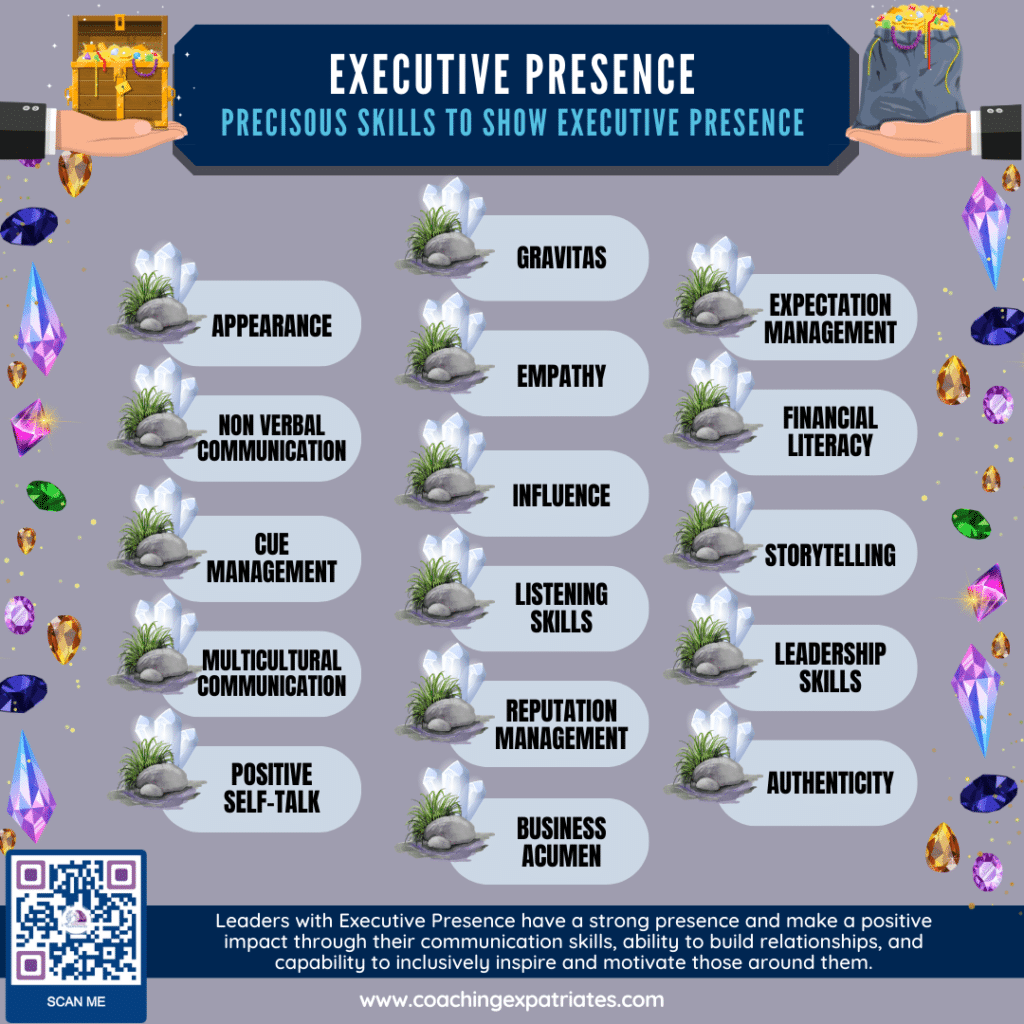
Incorporating and honing these skills will not only amplify your executive presence but also set you on a path to becoming a truly influential leader in the corporate world.
The Role Of Multicultural Competence And Communication In Executive Presence
If you’re still not sufficiently intrigued by the notion that executive presence comprises not just one skill, but rather a constellation of distinct competencies, it’s because we haven’t yet delved into two of its foundational elements.
Executive presence is not solely about projecting confidence, authority, and leading with all the other skills mentioned above; it’s also about possessing the finesse to navigate diverse cultural terrain.
Cultural competence, a profound understanding and appreciation of various cultures, is a paramount facet of executive presence. It is not merely an option but a necessity for leaders seeking to thrive in a multicultural environment. Why is cultural competence so pivotal in executive presence, and how does it connect with multicultural communication? Let’s explore.
Cultural Competence: The Foundation of Authentic Leadership
Cultural competence is the bedrock upon which authentic leadership is built. It involves being aware of one’s own cultural biases and prejudices while displaying an openness to embrace and learn from other cultures. This self-awareness helps leaders connect on a deeper level with their diverse teams and stakeholders, fostering trust and respect. When leaders exhibit cultural competence, they send a powerful message of inclusivity and fairness, essential components of executive presence at all levels.
Multicultural Communication: The Bridge to Trust
Now, let’s delve into the role of multicultural communication. Effective communication across cultures is not just a skill; it’s an art form. It enables leaders to convey their ideas, intentions, and vision in a manner that transcends linguistic and cultural barriers. Leaders who master this art by learning High and Low-Context Cultural Communication, The Lewis Model, and The Cultural Map, amongst other multicultural understanding and communication theories, can facilitate collaboration, resolve conflicts, and inspire action across multicultural teams. On top of knowing these models, active listening, empathy, and non-verbal cues become indispensable tools in a leader’s repertoire. As you can see, they are all connected.
Practical Strategies In Corporate Settings
So, how can one practice these skills in corporate settings to enhance their executive presence? Here are a few practical strategies:
- Cross-Cultural Training: Encourage leaders to undergo cross-cultural training programs that expose them to different cultural norms and communication styles. It’s vital that these training programs incorporate Models of Multicultural Understanding, encompassing diverse behavioral and communication preferences. This equips participants with the agility to navigate and lead in a myriad of cultural contexts adeptly. Providing them with the perfect grounds to also experience positive hands-on interactions for practice will foster cultural competence growth over time. This can happen through international short-term assignments, conferences, or training simulations.
- Diverse Leadership Teams: Foster diversity in leadership teams to create a melting pot of perspectives and experiences. When leaders work closely with diverse colleagues, they naturally develop multicultural communication skills. A leader once told me that he distributed tasks in his organization through a task marketplace. I asked him, “How do you ensure all tasks get picked?” And he told me his team was so diverse that there were tastes for all types of tasks. This is the diversity level you should look into in any team.
- Cultural Sensitivity Workshops: Organize workshops that delve into cultural sensitivity, addressing issues such as unconscious bias. These workshops promote self-awareness and cultural competence.
- Mentorship and Role Models: Encourage mentorship programs that pair leaders with mentors from diverse backgrounds. Learning from role models who excel in multicultural communication can be a transformative experience. For both individuals, mind you.
Cultural competence and multicultural communication are not merely add-ons to executive presence; they are fundamental pillars that sustain it. Leaders who master these skills find themselves not only navigating the complex web of global business with finesse but also leaving an indelible mark as authentic, inclusive, and effective leaders.
3 Secret Weapons To Develop Executive Presence Faster
In the relentless — and let’s be frank, competitive — arena of the global corporate world, executive presence is the concealed currency that sets the truly exceptional apart from the rest. It’s the intangible force that exudes confidence, commands respect, and inspires trust. To ascend the ranks and thrive on this grand stage, one must harness the three secret weapons that distinguish the giants from the mere mortals. Here are my curated top 3 secret weapons from kings and queens in global corporations:
1. The Power of Authenticity: Authenticity is the secret weapon that forges an indelible connection between you and your global audience. It is not about imitating others or wearing a mask of pretense. Authenticity requires you to be genuinely you, embrace your strengths, and acknowledge your vulnerabilities. When you step into the spotlight as your authentic self, you radiate a magnetic charisma that transcends cultural boundaries. Be it in Tokyo or New York, Johannesburg or Mumbai, authenticity is a universal language that resonates with authenticity, breeding trust and inspiring others to follow your lead. So long as you know the art of reputation management and can manage your personal brand, authenticity is a key element in executive presence.
Leading by example: One exemplary figure renowned for their authenticity in leadership is Nelson Mandela, the iconic anti-apartheid revolutionary and former President of South Africa. Mandela’s authenticity was a cornerstone of his leadership, and it was this authenticity that made him a global symbol of hope and reconciliation. Nelson Mandela’s authenticity as a leader shone through his transparency, consistency, empathy, inclusivity, and forgiveness. These characteristics made him not only an authentic leader but also an enduring symbol of hope, reconciliation, and transformation in the global arena. His authenticity resonated with people worldwide, transcending cultural and geographical boundaries.
2. The Mastery of Cross-Cultural Communication: In our interconnected world, executive presence is not confined to your home turf. So to speak. It extends across continents and cultures. The ability to navigate the intricacies of cross-cultural communication is a secret weapon that can elevate you to a global leadership pedestal. Learn the nuances of different cultures, understand the subtleties of body language, and adapt your communication style accordingly. In doing so, you become a bridge between cultures, a beacon of understanding, and a symbol of unity in diversity. Did you read well what I said? Unity in diversity. It’s so beautiful when it happens! When it happens, no, it’s not just luck, it’s mastery.
Leading by example: A prominent leader known for their mastery of cross-cultural communication is Angela Merkel, the former Chancellor of Germany. Merkel’s adeptness in this area played a pivotal role in her global leadership. Angela Merkel’s mastery of cross-cultural communication was rooted in her language proficiency, cultural sensitivity, active listening, adaptability, and global perspective. These qualities not only enhanced her leadership on the world stage but also contributed to her reputation as a leader who could bridge cultural divides and foster cooperation among nations. Her skill in this area made her a respected and influential figure in global politics.
3. The Art of Resilience: In the current competitive corporate battleground, challenges are a constant companion. Resilience, the secret weapon of the elite, enables you to weather storms and emerge stronger. Embrace setbacks as stepping stones to success, displaying unwavering determination and composure even in the face of adversity. Your ability to bounce back and lead your team with grace in the most trying times is a testament to your executive presence, earning you the unwavering loyalty of those who follow your lead. To support resilience, there are 2 vital skills that you’ll need: emotional regulation and a growth and success mindset. No one is immune to setbacks, but when possessed with growth mindset and skilled in emotional regulation, you can manage your stress levels, self-talk, and even your confidence. That’s why it is so vital. There is an anatomy of success that embodies the growth and success mindset, and I recommend you read our article on this topic to create your foundation for resilience.
Leading by example: A notable leader celebrated for their resilience is Winston Churchill, the iconic Prime Minister of the United Kingdom during World War II. Churchill’s indomitable spirit and resilience in the face of immense challenges are legendary. Winston Churchill’s resilience as a leader was marked by determination, optimism, adaptability, stoicism, and inspiring communication. These characteristics not only helped him lead the United Kingdom through one of its most challenging periods but also made him a global symbol of resilience in the face of adversity. His leadership serves as a timeless example of how unwavering determination and resilience can inspire others to persevere through the toughest of times.
Incorporate these secret weapons into your arsenal, and you will not only develop an unassailable executive presence over time with experience but also become a guiding force that leaves an indelible mark on the global corporate world. Maybe I’m being too bold, but that’s what I wish for myself, and I wish it for you too. Be authentic, communicate effectively across cultures, and exhibit unyielding resilience, for in these qualities lies the power to conquer corporate complexities and inspire greatness in all who have the privilege of working with you.
5 Useful Books On Executive Presence
Here are some favorite books on the topic or that supports this topic:
Executive Presence: The Missing Link Between Merit And Success
by Sylvia Ann Hewlett
Hewlett draws upon extensive research, case studies, and interviews with successful leaders to provide practical advice and strategies for cultivating executive presence. She demonstrates how mastering this quality can help individuals break through barriers, gain the recognition they deserve, and achieve their professional goals. In essence, “Executive Presence” serves as a guide for professionals aiming to bridge the gap between their qualifications and career advancement by developing the intangible yet essential attributes that make up executive presence. It is a valuable resource for anyone looking to enhance their leadership potential and thrive in the competitive world of business and organizational leadership.
Executive Presence: Step Into Your Power, Convey Confidence, & Lead With Conviction
by Joel A. Garfinkle
Garfinkle provides a comprehensive guide on how to harness and project executive presence to maximize one’s professional impact. The book emphasizes the significance of confidence, self-assured communication, and unwavering conviction as essential components of executive presence. Garfinkle offers practical advice, actionable strategies, and real-world examples to help readers develop the demeanor and attributes that command attention and respect in a corporate setting. By delving into the nuances of executive presence, this book not only equips readers with the tools to enhance their leadership potential but also helps them navigate their careers more effectively, ultimately bridging the gap between merit and success in the business world.
Composure: The Art of Executive Presence
by Kate Purmal, Lee Epting, Joshua Isaac Smith
Using proven techniques, relatable case studies, and comprehensive exercises, this book shows you how to compose yourself to elevate your presence at work, home, and, ultimately, within yourself, no matter how hectic or overwhelming your life may feel. Drawing on more than twenty years of experience as corporate executives, and executive coaches, and their expertise in neurolinguistics, trauma and PTSD therapy, Kate Purmal and her colleagues Lee Epting and Joshua Isaac Smith deliver a unique approach to navigating work environments that don’t feel psychologically safe.
Executive Presence, Second Edition: The Art of Commanding Respect Like a CEO
by Harrison Monarth
It is one of the few books that includes a full chapter on reputation management. This, alone, makes the book earn the right to be in our top 5 here. The book is a comprehensive guide that provides readers with actionable insights and strategies to develop a commanding executive presence. Drawing from Monarth’s expertise in leadership development and communication, the book explores how to project confidence, authenticity, and gravitas in the business world. Monarth offers practical advice on refining one’s communication skills, enhancing self-awareness, and mastering the subtle yet powerful nuances of executive presence. With real-life examples and proven techniques, the book equips professionals at all levels with the tools they need to make a lasting impression, gain respect, and advance their careers. This second edition serves as a valuable resource for those aspiring to excel in leadership roles by honing the essential qualities that set CEOs and successful leaders apart in today’s competitive business landscape.
Cues: Master the Secret Language of Charismatic Communication
by Vanessa Van Edwards
The book is a compelling exploration of the hidden signals and nonverbal cues that underlie charismatic communication and presence. Drawing from the author’s expertise in human behavior and interpersonal dynamics, the book deciphers the science behind charisma and offers practical insights on how individuals can harness the power of nonverbal communication to become more captivating and influential in both personal and professional interactions. Through a blend of research-backed advice and real-world examples, readers will learn how to fine-tune their body language, vocal tone, and social cues to exude charisma and connect more effectively with others. Van Edwards provides a valuable resource for those seeking to enhance their executive presence by mastering the subtle but impactful language of charisma. This has been one of my favorite non-fictional books, lately.
Final Remarks
In our journey through this long blog post, we’ve explored the essence of executive presence, the art of global leadership, the significance of strategic decisions, the power of multicultural communication, and the vital role of cultural competence. Whether it’s learning from the authenticity of leaders like Nelson Mandela, the cross-cultural finesse of Angela Merkel, or the resilience of Winston Churchill, we’ve witnessed how these qualities elevate leadership to remarkable heights.
Remember that executive presence isn’t an elusive trait, as I used to think it was at the beginning of my career. It’s a dynamic blend of very specific skills, behaviors, and characteristics that can be honed and mastered. It’s about authenticity, cultural sensitivity, adaptability, financial literacy, and, above all, the ability to inspire and motivate, among a list of many other things.
As you continue your journey in the corporate world or any endeavor, keep in mind the three secret weapons we discussed: authenticity, multicultural communication, and resilience. These are the keys that will unlock doors to leadership excellence. See them as the foundation for all your stepping stones. So, stand tall, embrace the challenges, and lead with unwavering presence, for your journey to success is a story waiting to be written. And I hope one day, I can tell your story here, too.
If you are looking for a leadership development partner and consultant to help you improve executive presence and implement some of the ideas from this post, you can hire me as your executive and development coach. Have a Free Strategy Call with me. We will go over your specific situation, and devise together a methodical but fun way to turn your tables on this matter. We will implement practices and ideas together during our coaching journey so you can feel more confident and poised.
If you are interested in developing specific global leadership skills, personally or team-wise, check out our online Global Executive Leadership program. We go over all The Global Leadership Pillars™ during 9 online modules, specially meant for global leadership development. It’s a unique leadership training methodology that will change the way you think, relate, and strategize as a global leader. You can also subscribe to our global leadership podcast, The Leadership Nest.
If you enjoyed this post, consider subscribing to our newsletter using the form below. We focus on providing good content to global leaders and executives who want to make impactful business decisions and be more inclusive and influential. We know your inbox is sacred, so we email just once per week, and we never sell, rent, or do anything funky with your information. Trust is the basis of Global Leadership, and we fully honor it.

